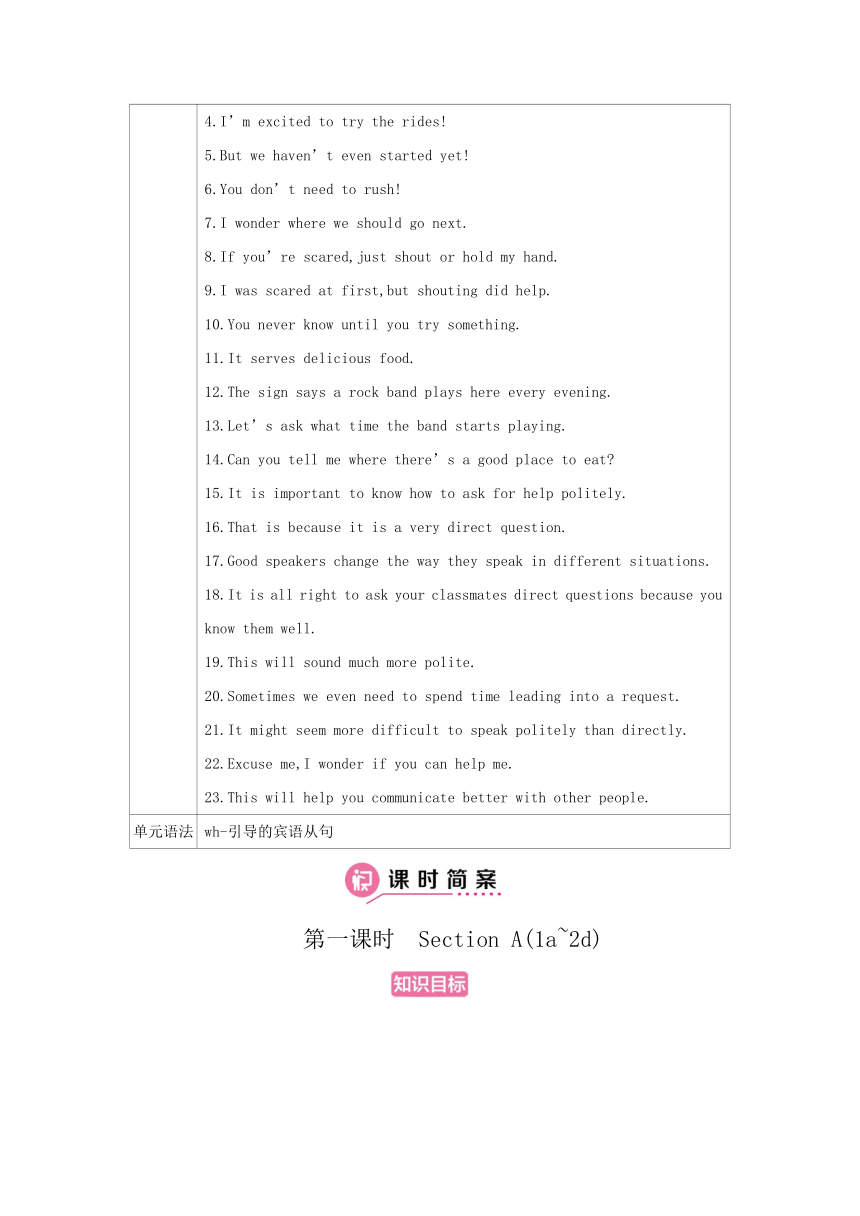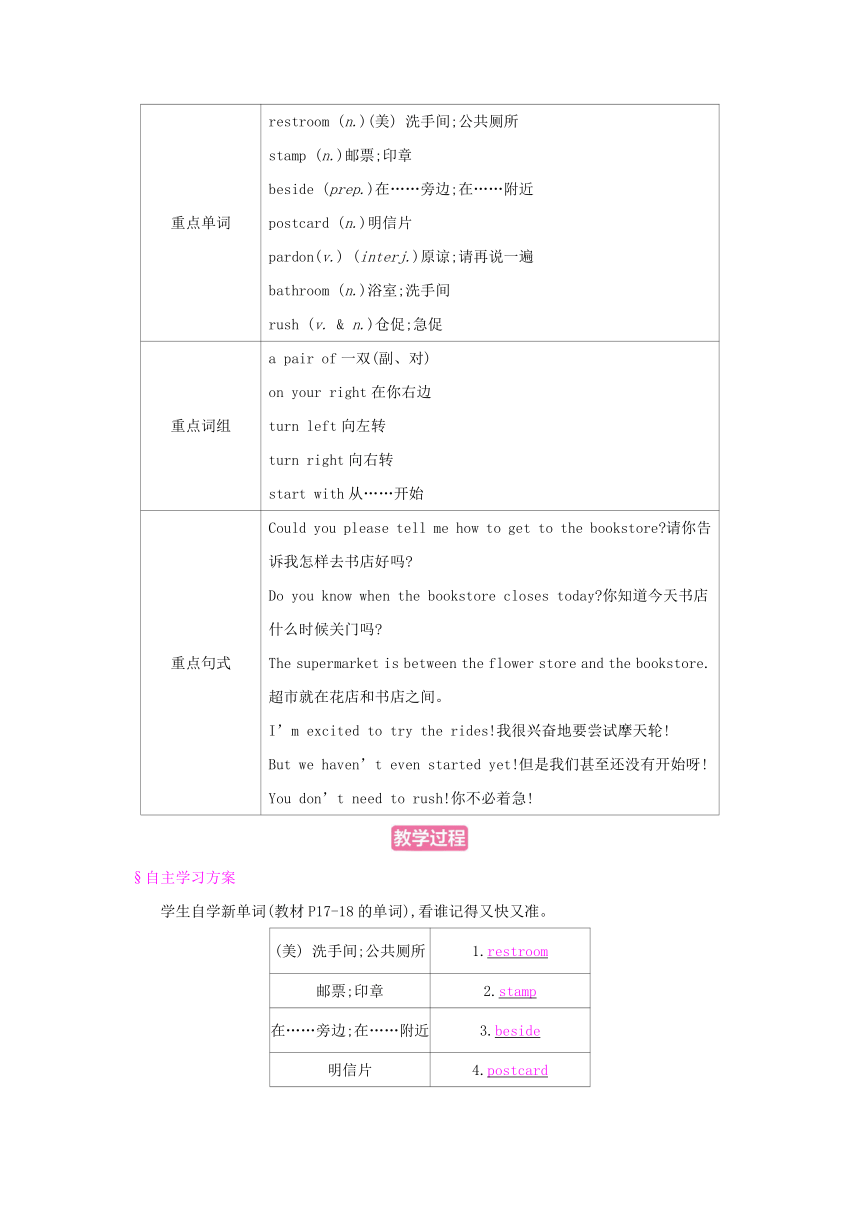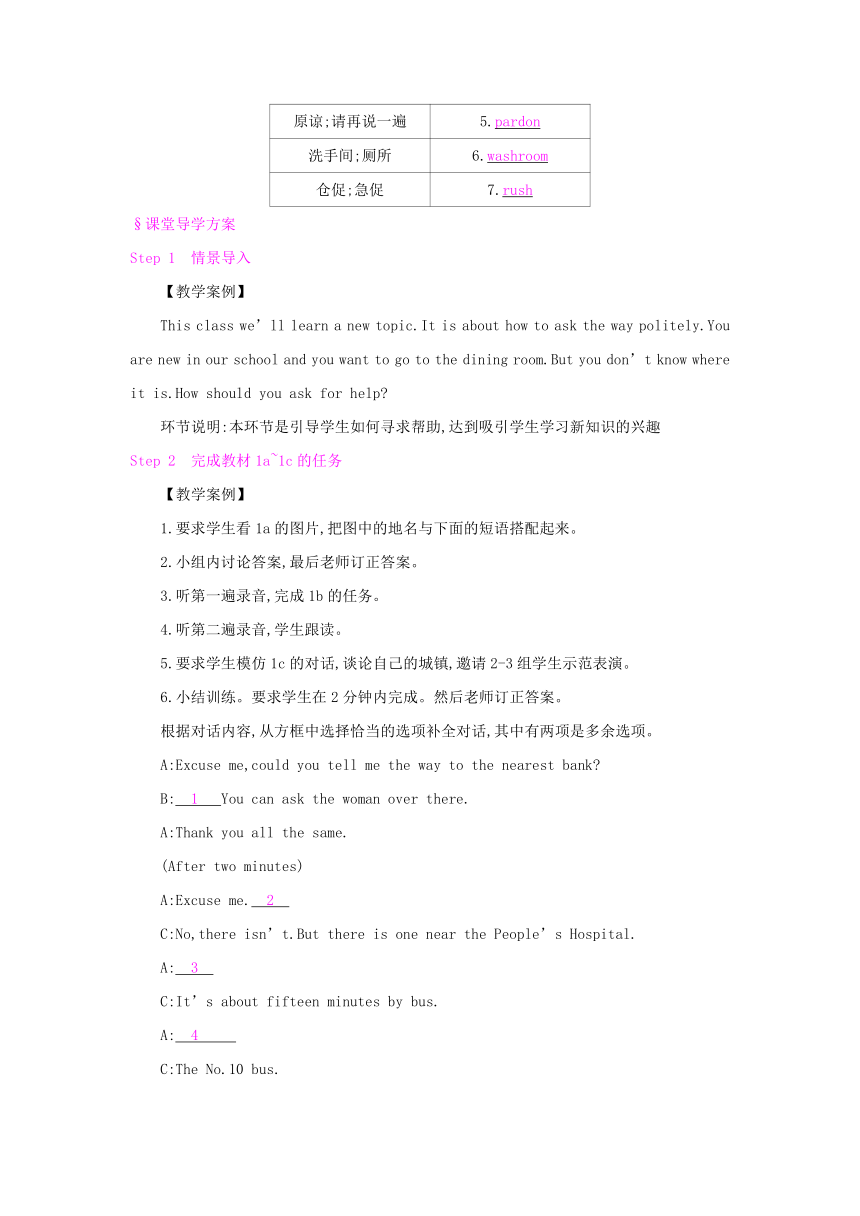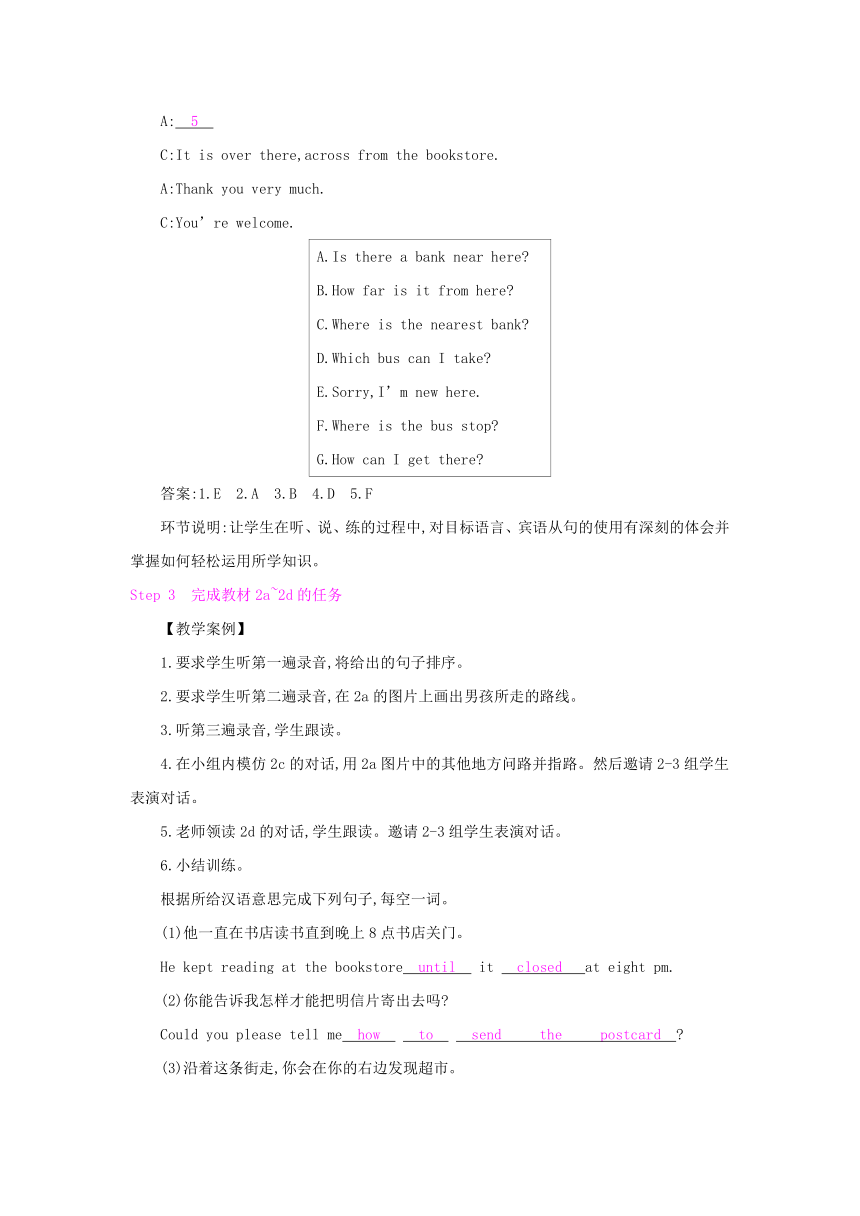Unit 3 Could you please tell me where the restrooms are? 单元教学案(4课时)
文档属性
| 名称 | Unit 3 Could you please tell me where the restrooms are? 单元教学案(4课时) |  | |
| 格式 | docx | ||
| 文件大小 | 84.3KB | ||
| 资源类型 | 教案 | ||
| 版本资源 | 人教新目标(Go for it)版 | ||
| 科目 | 英语 | ||
| 更新时间 | 2021-09-11 13:23:49 | ||
图片预览





文档简介
Unit
3
Could
you
please
tell
me
where
the
restrooms
are?
类别
课程标准要求掌握的项目
单元话题
Getting
around
重点单词
1.restroom(n.)
2.stamp(n.)
3.postcard(n.)
4.bathroom
(n.)
5.grape(n.)
6.corner
(n.)
7.request
(n.
&
v.)
8.direction
(n.)
9.speaker (n.)
10.address
(n.)
11.course
(n.)
12.pardon(v.)
(interj.)
13.rush(v.
&
n.)
14.suggest(v.)
15.mail
(v.)
(n.)
16.central(adj.)
17.east
(adj.)
(adv.)
(n.)
18.convenient
(adj.)
19.correct
(adj.)
20.direct
(adj.)
21.polite(adj.)
22.impolite
(adj.)
23.underground
(adj.)(n.)
24.whom(pron.)
25.beside(prep.)
重点词组
1.a
pair
of
2.on
your
right
3.turn
left
4.turn
right
5.start
with
6.come
on
7.at
first
8.on
one’s
way
to
9.pass
by
10.walk
up
11.at
that
time
12.pardon
me
13.shopping
center
14.along
the
street
15.foreign
country
16.ask
for
help
17.in
different
situations
18.depend
on
19.each
other
20.such
as
21.e-mail
address
22.lead
in
23.parking
lot
24.the
village
school
重点句式
1.Could
you
please
tell
me
how
to
get
to
the
bookstore?
2.Do
you
know
when
the
bookstore
closes
today?
3.The
supermarket
is
between
the
flower
store
and
the
bookstore.
4.I’m
excited
to
try
the
rides!
5.But
we
haven’t
even
started
yet!
6.You
don’t
need
to
rush!
7.I
wonder
where
we
should
go
next.
8.If
you’re
scared,just
shout
or
hold
my
hand.
9.I
was
scared
at
first,but
shouting
did
help.
10.You
never
know
until
you
try
something.
11.It
serves
delicious
food.
12.The
sign
says
a
rock
band
plays
here
every
evening.
13.Let’s
ask
what
time
the
band
starts
playing.
14.Can
you
tell
me
where
there’s
a
good
place
to
eat?
15.It
is
important
to
know
how
to
ask
for
help
politely.
16.That
is
because
it
is
a
very
direct
question.
17.Good
speakers
change
the
way
they
speak
in
different
situations.
18.It
is
all
right
to
ask
your
classmates
direct
questions
because
you
know
them
well.
19.This
will
sound
much
more
polite.
20.Sometimes
we
even
need
to
spend
time
leading
into
a
request.
21.It
might
seem
more
difficult
to
speak
politely
than
directly.
22.Excuse
me,I
wonder
if
you
can
help
me.
23.This
will
help
you
communicate
better
with
other
people.
单元语法
wh-引导的宾语从句
第一课时 Section
A(1a~2d)
重点单词
restroom
(n.)(美)
洗手间;公共厕所
stamp
(n.)邮票;印章
beside
(prep.)在……旁边;在……附近
postcard
(n.)明信片
pardon(v.)
(interj.)原谅;请再说一遍
bathroom
(n.)浴室;洗手间
rush
(v.
&
n.)仓促;急促
重点词组
a
pair
of一双(副、对)
on
your
right在你右边
turn
left向左转
turn
right向右转
start
with从……开始
重点句式
Could
you
please
tell
me
how
to
get
to
the
bookstore?请你告诉我怎样去书店好吗?
Do
you
know
when
the
bookstore
closes
today?你知道今天书店什么时候关门吗?
The
supermarket
is
between
the
flower
store
and
the
bookstore.超市就在花店和书店之间。
I’m
excited
to
try
the
rides!我很兴奋地要尝试摩天轮!
But
we
haven’t
even
started
yet!但是我们甚至还没有开始呀!
You
don’t
need
to
rush!你不必着急!
§自主学习方案
学生自学新单词(教材P17-18的单词),看谁记得又快又准。
(美)
洗手间;公共厕所
1.restroom
邮票;印章
2.stamp
在……旁边;在……附近
3.beside
明信片
4.postcard
原谅;请再说一遍
5.pardon
洗手间;厕所
6.washroom
仓促;急促
7.rush
§课堂导学方案
Step
1 情景导入
【教学案例】
This
class
we’ll
learn
a
new
topic.It
is
about
how
to
ask
the
way
politely.You
are
new
in
our
school
and
you
want
to
go
to
the
dining
room.But
you
don’t
know
where
it
is.How
should
you
ask
for
help?
环节说明:本环节是引导学生如何寻求帮助,达到吸引学生学习新知识的兴趣
Step
2 完成教材1a~1c的任务
【教学案例】
1.要求学生看1a的图片,把图中的地名与下面的短语搭配起来。
2.小组内讨论答案,最后老师订正答案。
3.听第一遍录音,完成1b的任务。
4.听第二遍录音,学生跟读。
5.要求学生模仿1c的对话,谈论自己的城镇,邀请2-3组学生示范表演。
6.小结训练。要求学生在2分钟内完成。然后老师订正答案。
根据对话内容,从方框中选择恰当的选项补全对话,其中有两项是多余选项。
A:Excuse
me,could
you
tell
me
the
way
to
the
nearest
bank?
B: 1
You
can
ask
the
woman
over
there.?
A:Thank
you
all
the
same.
(After
two
minutes)
A:Excuse
me. 2
?
C:No,there
isn’t.But
there
is
one
near
the
People’s
Hospital.
A: 3
?
C:It’s
about
fifteen
minutes
by
bus.
A: 4
?
C:The
No.10
bus.
A: 5
?
C:It
is
over
there,across
from
the
bookstore.
A:Thank
you
very
much.
C:You’re
welcome.
A.Is
there
a
bank
near
here?
B.How
far
is
it
from
here?
C.Where
is
the
nearest
bank?
D.Which
bus
can
I
take?
E.Sorry,I’m
new
here.
F.Where
is
the
bus
stop?
G.How
can
I
get
there?
答案:1.E 2.A 3.B 4.D 5.F
环节说明:让学生在听、说、练的过程中,对目标语言、宾语从句的使用有深刻的体会并掌握如何轻松运用所学知识。
Step
3 完成教材2a~2d的任务
【教学案例】
1.要求学生听第一遍录音,将给出的句子排序。
2.要求学生听第二遍录音,在2a的图片上画出男孩所走的路线。
3.听第三遍录音,学生跟读。
4.在小组内模仿2c的对话,用2a图片中的其他地方问路并指路。然后邀请2-3组学生表演对话。
5.老师领读2d的对话,学生跟读。邀请2-3组学生表演对话。
6.小结训练。
根据所给汉语意思完成下列句子,每空一词。
(1)他一直在书店读书直到晚上8点书店关门。
He
kept
reading
at
the
bookstore until
it
closed
at
eight
pm.?
(2)你能告诉我怎样才能把明信片寄出去吗?
Could
you
please
tell
me how
to
send
the
postcard ??
(3)沿着这条街走,你会在你的右边发现超市。
Go
along
this
street
and
you’ll
find
the
supermarket
on
your
right .?
(4)如果你想到达银行,你需要经过图书馆。
You need
to
go
past
the
library
if
you
want
to
get
to
the
bank.?
(5)劳驾,你知道我能在哪里买一双鞋吗?
Excuse
me,do
you
know where
I
can
get
a
pair
of
shoes??
环节说明:通过本环节的学习让学生通过听、说、写的训练,对目标语言有更明确的运用。
第二课时 Section
A(3a~4c)
重点单词
suggest(v.)建议;提议
grape
(n.)葡萄
central
(adj.)中心的;中央的
mail
(v.)邮寄;发电子邮件;(n.)邮件;信件
east
(adj.)东方的;东部的;(adv.)向东;朝东;(n.)东;东方
重点词组
come
on加油
at
first首先
on
one’s
way
to在某人去……的路上
pass
by路过;经过
walk
up向上走
at
that
time在那时
pardon
me抱歉;对不起;什么;请再说一遍
shopping
center购物中心
重点句式
I
wonder
where
we
should
go
next.我想知道我们接下来应该去哪里。
If
you’re
scared,just
shout
or
hold
my
hand.如果你害怕,就大喊或者握紧我的手。
I
was
scared
at
first,but
shouting
did
help.我刚开始害怕,但是大喊确实有帮助。
You
never
know
until
you
try
something.直到你尝试了,你才会知道。
It
serves
delicious
food.它提供可口的食物。
The
sign
says
a
rock
band
plays
here
every
evening.标牌上写着每天晚上有个摇滚乐队在这里演出。
Let’s
ask
what
time
the
band
starts
playing.让我们问问乐队什么时间开始演出吧。
§自主学习方案
学生自学新单词(教材P19—20的单词),看谁记得又快又准。
建议;提议
1.suggest
葡萄
2.grape
中心的;中央的
3.central
邮寄;发电子邮件;邮件;信件
4.mail
东方的;东部的;向东;朝东;东;东方
5.east
§课堂导学方案
Step
1 情景导入
【教学案例】
上节课我们学了如何问路和如何指路,这节课我们要去参观一个娱乐公园。看看课文中是怎样描述的吧。
通过一些图片,给同学们展示公园的一些设施。并向学生提问。
1.What
do
you
think
of
the
park?
2.Have
you
been
to
the
park?
3.How
do
you
get
to
the
park?
环节说明:用图片展示,让学生有身临其境的感觉,引发学生进一步学习和探索的欲望。
Step
2 完成教材3a~3b的任务
【教学案例】
1.让学生带着问题默读课文。完成3a的问题。
2.邀请2-3个学生回答这两个问题,然后全班一起订正。
3.讲解文中的重点句式和词语。
★On
their
way
to
Water
City
Restaurant,Alice
and
He
Wei
pass
by
Uncle
Bob’s.
(1)on
one’s
way
to
意为“在某人去……的路上”。
Yesterday
I
met
a
friend
of
mine
on
my
way
to
school.昨天在上学的路上我遇见了我的一个朋友。
【拓展】 常见的与way相关的短语还有:
(2)Uncle
Bob’s
=Uncle
Bob’s
restaurant,当名词所有格限定的是表示住宅、诊所、商店等的名词时,该名词通常可以省略。
They
are
at
the
doctor’s
(office).他们在医生办公室。
He
is
going
to
his
aunt’s
(house)
this
Sunday.这个周日他将要去他姑姑家。
4.要求学生再次默读课文,画出对话中询问信息的问题或句子,并按照3b的例句用不同的方式改写。要求学生最少写2个句子。让2个学生在黑板上写出句子。
I
wonder
where
we
should
go
next.
Could
you
tell
me
where
we
could
go
next?
环节说明:本环节以读为主,在读中解决问题,通过对重点句式和词语的掌握培养学生解决问题的能力。
Step
3 完成教材Grammar
Focus的任务
【教学案例】
1.找2个学生朗读这几个句子,并翻译成汉语。
2.老师引导学生找出这几个句子所包含的句式及宾语从句的构成。
环节说明:本环节以学生自学为主,老师引导为辅,培养学生的思考能力。
Step
4 完成教材4a~4c的任务
【教学案例】
1.改写句子,使问句更加礼貌地表达,完成4a的任务。
(答案:1.Could
you
please
tell
me
where
I
can
buy
some
grapes
or
other
fruit?2.Could
you
please
teach
me
how
to
use
this
CD
player?3.Could
you
please
tell
me
how
to
get
to
the
Central
Library?4.Excuse
me,do
you
know
if
the
Italian
restaurant
nearby
is
open
on
Mondays?)
2.要求学生在小组内讨论在4b的情景中应当如何更加礼貌地表达。邀请2-3个学生读出自己的答案。
3.要求学生先写出关于游客可能问及的四个问题,并给出答案。然后在小组内表演对话,完成4c。
4.小结训练。
将下列句子改为含有宾语从句的复合句。
(1)Where
is
the
No.5
Middle
School?
The
boy
is
asking
where
the
No.5
Middle
School
is.?
(2)Can
we
reach
the
village
before
dark?
Could
you
tell
me
if
we
can
reach
the
village
before
dark??
(3)When
can
we
live
a
normal
life?
We
all
wonder
when
we
can
live
a
normal
life.?
(4)Are
there
new
rides
in
the
amusement
park?
Do
you
know
if
there
are
new
rides
in
the
amusement
park??
(5)Why
was
Mr.
Li
late
for
the
meeting
this
morning?
We
don’t
know
why
Mr.Li
was
late
for
the
meeting
this
morning.?
环节说明:将听、说、读、写的任务结合起来,能锻炼学生的语言运用能力,同时巩固了目标语言的识记和运用。
第三课时 Section
B(1a~1e)
重点单词
convenient(adj.)
便利的;方便的
corner
(n.)
拐角;角落
重点词组
of
course
重点句式
Can
you
tell
me
where
there’s
a
good
place
to
eat?你能告诉我哪里有吃饭的好地方吗?
§自主学习方案
学生自学新单词(教材P21的单词),看谁记得又快又准。
迷人的;极有吸引力的
1.fascinating
不昂贵的
2.inexpensive
不拥挤的;人少的
3.uncrowded
便利的;方便的
4.convenient
商场;购物中心
5.mall
拐角;角落
6.corner
职员
7.clerk
§课堂导学方案
Step
1 情景导入
【教学案例】
上节课,我们参观了一个娱乐公园,学了宾语从句的构成。今天这节课让我们来评论一下这几个不同地方有什么特点。请翻到课本第21页。
环节说明:本环节的话题是转向对服务设施的评论,是上节课的话题的延伸。
Step
2 完成教材1a~1b的任务
【教学案例】
1.把你认为对这些设施最为重要的特征的单词填入表格中,完成1a的任务。
2.要求同学们就1a的内容,用1b的对话模式来演练对话。然后就自己城市的设施来展开对话。邀请2-3组同学来演练。
环节说明:本环节以自学为主,培养同学们的自学能力。
Step
3 完成教材1c~1e的任务
【教学案例】
1.听一遍录音,完成1c的任务。
2.再听一遍录音,订正答案。
3.找两个学生分角色朗读1e的对话。然后邀请2-3组学生仿照对话,编一个类似的对话。完成1e的任务。
4.小结训练。
根据对话情景,在每个空白处填上一个适当的句子,使对话的意思连贯、完整。
A:Excuse
me,I
am
on
business
here
and
I
see
a
big
bookstore
nearby
on
my
mobile
phone.1.Could
you
tell
me
how
I
can
get
there
/
where
the
bookstore
is??
B:Yes.Cross
the
bridge
and
go
to
the
other
side
of
the
road.Go
west
until
you
see
a
large
shopping
mall.The
bookstore
is
just
on
the
right.
A:I
see.Do
you
know
if
it
is
open
now?
B:2.Yes,it’s
open
/
Certainly
/
Sure.It
closes
at
8:30
in
the
evening.It’s
still
early
now.?
A:Are
there
any
dictionaries
in
the
bookstore?
B:Yes,there
are
many
dictionaries
on
the
third
floor.
A:What
about
children’s
books?
B:3.They
are
on
the
second
/
fourth
/
fifth
floor.?
A:It
seems
you
know
the
bookstore
very
well.4.Do
you
often
go
/
read
there??
B:Yes.As
long
as
I’m
free,I’ll
go
there
to
do
some
reading.
A:5.How
long
does
it
take
me
to
walk
there??
B:About
5
minutes.
A:Thanks
very
much.
环节说明:本环节以听为主,在听的训练中,锻炼学生们的口语表达,巩固了目标语言。
第四课时 Section
B(2a~Self
Check)
重点单词
politely
(adv.)礼貌地;客气地
request
(n.
&
v.)要求;请求
direction
(n.)方向;方位
correct
(adj.)正确的;恰当的
polite
(adj.)有礼貌的;客气的
direct
(adj.)直接的;直率的
speaker(n.)讲(某种语言)的人;发言者
whom(pron.)谁;什么人
impolite
(adj.)不礼貌的;粗鲁的
address
(n.)住址;地址;通讯处
underground
(adj.)
地下的
(n.)
地铁
course
(n.)课程;学科
重点词组
foreign
country外国
ask
for
help寻求帮助
in
different
situations在不同的情形中
depend
on依靠
each
other互相;彼此
such
as例如
e-mail
address电子邮件地址
lead
in导入
parking
lot停车场
the
village
school
乡村学校
重点句式
It
is
important
to
know
how
to
ask
for
help
politely.知道怎样礼貌地寻求帮助是重要的。
That
is
because
it
is
a
very
direct
question.那是因为它是一个很直接的问题。
Good
speakers
change
the
way
they
speak
in
different
situations.好的说话者改变他们在不同的情况下的说话方式。
It
is
all
right
to
ask
your
classmates
direct
questions
because
you
know
them
well.问你的同学直接的问题是可以的,因为你非常了解他们。
This
will
sound
much
more
polite.这听起来将礼貌得多。
Sometimes
we
even
need
to
spend
time
leading
into
a
request.有时我们甚至需要花费时间导入
重点句式
一个需求。
It
might
seem
more
difficult
to
speak
politely
than
directly.也许看上去礼貌地说出比直接地表达更难。
Excuse
me,I
wonder
if
you
can
help
me.打扰了,我想知道你是否能帮助我。
This
will
help
you
communicate
better
with
other
people.这将帮助你与别人更好地交流。
§自主学习方案
学生自学新单词(教材P22-24的单词),看谁记得又快又准。
礼貌地;客气地
1.politely
要求;请求
2.request
方向;方位
3.direction
正确的;恰当的
4.correct
有礼貌的;客气的
5.polite
直接的;直率的
6.direct
讲(某种语言)的人;发言者
7.speaker
谁;什么人
8.whom
不礼貌的;粗鲁的
9.impolite
住址;地址;通讯处
10.address
地下的;地铁
11.underground
课程;学科
12.course
§课堂导学方案
Step
1 情景导入
【教学案例】
本节课我们继续学习怎样能更加礼貌地表达需求,怎样更加委婉地叙述。
能礼貌地表达需求,显得说话者有教养。
环节说明:本环节说明了礼貌地说话的重要性,引起同学们学习的兴趣。
Step
2 完成教材2a~2d的任务
【教学案例】
1.要求学生默读课文。找出文章中每个段落的主题句。邀请1-2个学生读出自己所找的主题句。
第一段的主题句:When
you
visit
a
foreign
country,it
is
important
to
know
how
to
ask
for
help
politely.
第二段的主题句:Good
speakers
change
the
way
they
speak
in
different
situations.
第三段的主题句:Usually
polite
questions
are
longer.
第四段的主题句:It
might
seem
more
difficult
to
speak
politely
than
directly.
2.老师领读课文,学生跟读。
3.讲解课文中的重点句式和词语。
★That
is
because
it
is
a
very
direct
question.
(1)direct做形容词,意为“直接的”。比较级是more
direct,最高级是most
direct。
This
train
is
direct;you
do
not
have
to
change.这辆火车是直达的。你不需要换乘。
(2)direct做动词,意为“指导;导演”。direction
做名词,意为“方向”。director
做名词,意为“导演”。
★The
expressions
they
use
might
depend
on
whom
they
are
speaking
to
or
how
well
they
know
each
other.
(1)depend
on意为“视……而定;取决于”,后面可以接名词、代词或宾语从句。
The
way
to
go
to
school
depends
on
where
the
students
live.去学校的路取决于学生们在哪儿住。
(2)depend
on也可意为“依靠;相信”。
Children
depend
on
their
parents
for
food
and
clothing.孩子们的衣食依靠他们的父母。
★Sometimes
we
even
need
to
spend
time
leading
into
a
request.
(1)spend
some
money
/
time
(in)
doing
sth.意为“某人花一些金钱/时间做某事”。
Mr.
Brown
spent
most
of
his
money
(in)
buying
books.布朗先生把他大部分的钱花在了买书上。
(2)spend
some
money
/
time
on
sth.意为“在某方面
花费一些金钱或时间”。
I
had
spent
too
much
time
on
my
English,but
I
still
failed
this
time.我在英文方面花了太多的时间,但是这次我还是没有及格。
4.从课本中找出“直接的问题”和“礼貌的请求”,完成2c的任务。邀请1-2个学生朗读这些句子。
5.要求学生大声朗读2d中的句子,然后在小组内讨论一下这些句子用在什么情景中,是说给你认识的人还是说给陌生人的。
环节说明:本环节是以学生自学为主,让学生在读的基础上完成任务,从而对目标语言有更好的运用。
Step
3 完成教材3a~3b的任务
【教学案例】
1.要求学生就3a中所给出的话题,写出不直接或礼貌的问句。完成3a的任务。
Can
you
tell
me
what
course
I
will
study?
Could
you
please
tell
me
the
time
of
the
course?
Can
you
tell
me
where
and
what
I
can
eat?
Could
you
please
tell
me
where
I
will
stay?
Could
you
please
tell
me
what
activities
I
can
do?
Do
you
know
how
I
travel
to
the
school?
2.按照3b的要求写一封信,要求学生用礼貌的用语来询问某些事情。邀请1-2个学生读出自己的作文。
环节说明:本环节以写为主,是对目标语言的运用。
Step
4 完成教材Self
Check的任务
【教学案例】
1.用方框中的单词完成1的对话。要求学生边读边完成对话。邀请1-2个学生朗读这些对话。
2.参照2给出的例子,用所给单词写出问题并给出答案。邀请1-2个学生朗读这些对话。
环节说明:本环节主要是针对本单元的主要目标语言进行巩固训练。
3
Could
you
please
tell
me
where
the
restrooms
are?
类别
课程标准要求掌握的项目
单元话题
Getting
around
重点单词
1.restroom(n.)
2.stamp(n.)
3.postcard(n.)
4.bathroom
(n.)
5.grape(n.)
6.corner
(n.)
7.request
(n.
&
v.)
8.direction
(n.)
9.speaker (n.)
10.address
(n.)
11.course
(n.)
12.pardon(v.)
(interj.)
13.rush(v.
&
n.)
14.suggest(v.)
15.mail
(v.)
(n.)
16.central(adj.)
17.east
(adj.)
(adv.)
(n.)
18.convenient
(adj.)
19.correct
(adj.)
20.direct
(adj.)
21.polite(adj.)
22.impolite
(adj.)
23.underground
(adj.)(n.)
24.whom(pron.)
25.beside(prep.)
重点词组
1.a
pair
of
2.on
your
right
3.turn
left
4.turn
right
5.start
with
6.come
on
7.at
first
8.on
one’s
way
to
9.pass
by
10.walk
up
11.at
that
time
12.pardon
me
13.shopping
center
14.along
the
street
15.foreign
country
16.ask
for
help
17.in
different
situations
18.depend
on
19.each
other
20.such
as
21.e-mail
address
22.lead
in
23.parking
lot
24.the
village
school
重点句式
1.Could
you
please
tell
me
how
to
get
to
the
bookstore?
2.Do
you
know
when
the
bookstore
closes
today?
3.The
supermarket
is
between
the
flower
store
and
the
bookstore.
4.I’m
excited
to
try
the
rides!
5.But
we
haven’t
even
started
yet!
6.You
don’t
need
to
rush!
7.I
wonder
where
we
should
go
next.
8.If
you’re
scared,just
shout
or
hold
my
hand.
9.I
was
scared
at
first,but
shouting
did
help.
10.You
never
know
until
you
try
something.
11.It
serves
delicious
food.
12.The
sign
says
a
rock
band
plays
here
every
evening.
13.Let’s
ask
what
time
the
band
starts
playing.
14.Can
you
tell
me
where
there’s
a
good
place
to
eat?
15.It
is
important
to
know
how
to
ask
for
help
politely.
16.That
is
because
it
is
a
very
direct
question.
17.Good
speakers
change
the
way
they
speak
in
different
situations.
18.It
is
all
right
to
ask
your
classmates
direct
questions
because
you
know
them
well.
19.This
will
sound
much
more
polite.
20.Sometimes
we
even
need
to
spend
time
leading
into
a
request.
21.It
might
seem
more
difficult
to
speak
politely
than
directly.
22.Excuse
me,I
wonder
if
you
can
help
me.
23.This
will
help
you
communicate
better
with
other
people.
单元语法
wh-引导的宾语从句
第一课时 Section
A(1a~2d)
重点单词
restroom
(n.)(美)
洗手间;公共厕所
stamp
(n.)邮票;印章
beside
(prep.)在……旁边;在……附近
postcard
(n.)明信片
pardon(v.)
(interj.)原谅;请再说一遍
bathroom
(n.)浴室;洗手间
rush
(v.
&
n.)仓促;急促
重点词组
a
pair
of一双(副、对)
on
your
right在你右边
turn
left向左转
turn
right向右转
start
with从……开始
重点句式
Could
you
please
tell
me
how
to
get
to
the
bookstore?请你告诉我怎样去书店好吗?
Do
you
know
when
the
bookstore
closes
today?你知道今天书店什么时候关门吗?
The
supermarket
is
between
the
flower
store
and
the
bookstore.超市就在花店和书店之间。
I’m
excited
to
try
the
rides!我很兴奋地要尝试摩天轮!
But
we
haven’t
even
started
yet!但是我们甚至还没有开始呀!
You
don’t
need
to
rush!你不必着急!
§自主学习方案
学生自学新单词(教材P17-18的单词),看谁记得又快又准。
(美)
洗手间;公共厕所
1.restroom
邮票;印章
2.stamp
在……旁边;在……附近
3.beside
明信片
4.postcard
原谅;请再说一遍
5.pardon
洗手间;厕所
6.washroom
仓促;急促
7.rush
§课堂导学方案
Step
1 情景导入
【教学案例】
This
class
we’ll
learn
a
new
topic.It
is
about
how
to
ask
the
way
politely.You
are
new
in
our
school
and
you
want
to
go
to
the
dining
room.But
you
don’t
know
where
it
is.How
should
you
ask
for
help?
环节说明:本环节是引导学生如何寻求帮助,达到吸引学生学习新知识的兴趣
Step
2 完成教材1a~1c的任务
【教学案例】
1.要求学生看1a的图片,把图中的地名与下面的短语搭配起来。
2.小组内讨论答案,最后老师订正答案。
3.听第一遍录音,完成1b的任务。
4.听第二遍录音,学生跟读。
5.要求学生模仿1c的对话,谈论自己的城镇,邀请2-3组学生示范表演。
6.小结训练。要求学生在2分钟内完成。然后老师订正答案。
根据对话内容,从方框中选择恰当的选项补全对话,其中有两项是多余选项。
A:Excuse
me,could
you
tell
me
the
way
to
the
nearest
bank?
B: 1
You
can
ask
the
woman
over
there.?
A:Thank
you
all
the
same.
(After
two
minutes)
A:Excuse
me. 2
?
C:No,there
isn’t.But
there
is
one
near
the
People’s
Hospital.
A: 3
?
C:It’s
about
fifteen
minutes
by
bus.
A: 4
?
C:The
No.10
bus.
A: 5
?
C:It
is
over
there,across
from
the
bookstore.
A:Thank
you
very
much.
C:You’re
welcome.
A.Is
there
a
bank
near
here?
B.How
far
is
it
from
here?
C.Where
is
the
nearest
bank?
D.Which
bus
can
I
take?
E.Sorry,I’m
new
here.
F.Where
is
the
bus
stop?
G.How
can
I
get
there?
答案:1.E 2.A 3.B 4.D 5.F
环节说明:让学生在听、说、练的过程中,对目标语言、宾语从句的使用有深刻的体会并掌握如何轻松运用所学知识。
Step
3 完成教材2a~2d的任务
【教学案例】
1.要求学生听第一遍录音,将给出的句子排序。
2.要求学生听第二遍录音,在2a的图片上画出男孩所走的路线。
3.听第三遍录音,学生跟读。
4.在小组内模仿2c的对话,用2a图片中的其他地方问路并指路。然后邀请2-3组学生表演对话。
5.老师领读2d的对话,学生跟读。邀请2-3组学生表演对话。
6.小结训练。
根据所给汉语意思完成下列句子,每空一词。
(1)他一直在书店读书直到晚上8点书店关门。
He
kept
reading
at
the
bookstore until
it
closed
at
eight
pm.?
(2)你能告诉我怎样才能把明信片寄出去吗?
Could
you
please
tell
me how
to
send
the
postcard ??
(3)沿着这条街走,你会在你的右边发现超市。
Go
along
this
street
and
you’ll
find
the
supermarket
on
your
right .?
(4)如果你想到达银行,你需要经过图书馆。
You need
to
go
past
the
library
if
you
want
to
get
to
the
bank.?
(5)劳驾,你知道我能在哪里买一双鞋吗?
Excuse
me,do
you
know where
I
can
get
a
pair
of
shoes??
环节说明:通过本环节的学习让学生通过听、说、写的训练,对目标语言有更明确的运用。
第二课时 Section
A(3a~4c)
重点单词
suggest(v.)建议;提议
grape
(n.)葡萄
central
(adj.)中心的;中央的
(v.)邮寄;发电子邮件;(n.)邮件;信件
east
(adj.)东方的;东部的;(adv.)向东;朝东;(n.)东;东方
重点词组
come
on加油
at
first首先
on
one’s
way
to在某人去……的路上
pass
by路过;经过
walk
up向上走
at
that
time在那时
pardon
me抱歉;对不起;什么;请再说一遍
shopping
center购物中心
重点句式
I
wonder
where
we
should
go
next.我想知道我们接下来应该去哪里。
If
you’re
scared,just
shout
or
hold
my
hand.如果你害怕,就大喊或者握紧我的手。
I
was
scared
at
first,but
shouting
did
help.我刚开始害怕,但是大喊确实有帮助。
You
never
know
until
you
try
something.直到你尝试了,你才会知道。
It
serves
delicious
food.它提供可口的食物。
The
sign
says
a
rock
band
plays
here
every
evening.标牌上写着每天晚上有个摇滚乐队在这里演出。
Let’s
ask
what
time
the
band
starts
playing.让我们问问乐队什么时间开始演出吧。
§自主学习方案
学生自学新单词(教材P19—20的单词),看谁记得又快又准。
建议;提议
1.suggest
葡萄
2.grape
中心的;中央的
3.central
邮寄;发电子邮件;邮件;信件
4.mail
东方的;东部的;向东;朝东;东;东方
5.east
§课堂导学方案
Step
1 情景导入
【教学案例】
上节课我们学了如何问路和如何指路,这节课我们要去参观一个娱乐公园。看看课文中是怎样描述的吧。
通过一些图片,给同学们展示公园的一些设施。并向学生提问。
1.What
do
you
think
of
the
park?
2.Have
you
been
to
the
park?
3.How
do
you
get
to
the
park?
环节说明:用图片展示,让学生有身临其境的感觉,引发学生进一步学习和探索的欲望。
Step
2 完成教材3a~3b的任务
【教学案例】
1.让学生带着问题默读课文。完成3a的问题。
2.邀请2-3个学生回答这两个问题,然后全班一起订正。
3.讲解文中的重点句式和词语。
★On
their
way
to
Water
City
Restaurant,Alice
and
He
Wei
pass
by
Uncle
Bob’s.
(1)on
one’s
way
to
意为“在某人去……的路上”。
Yesterday
I
met
a
friend
of
mine
on
my
way
to
school.昨天在上学的路上我遇见了我的一个朋友。
【拓展】 常见的与way相关的短语还有:
(2)Uncle
Bob’s
=Uncle
Bob’s
restaurant,当名词所有格限定的是表示住宅、诊所、商店等的名词时,该名词通常可以省略。
They
are
at
the
doctor’s
(office).他们在医生办公室。
He
is
going
to
his
aunt’s
(house)
this
Sunday.这个周日他将要去他姑姑家。
4.要求学生再次默读课文,画出对话中询问信息的问题或句子,并按照3b的例句用不同的方式改写。要求学生最少写2个句子。让2个学生在黑板上写出句子。
I
wonder
where
we
should
go
next.
Could
you
tell
me
where
we
could
go
next?
环节说明:本环节以读为主,在读中解决问题,通过对重点句式和词语的掌握培养学生解决问题的能力。
Step
3 完成教材Grammar
Focus的任务
【教学案例】
1.找2个学生朗读这几个句子,并翻译成汉语。
2.老师引导学生找出这几个句子所包含的句式及宾语从句的构成。
环节说明:本环节以学生自学为主,老师引导为辅,培养学生的思考能力。
Step
4 完成教材4a~4c的任务
【教学案例】
1.改写句子,使问句更加礼貌地表达,完成4a的任务。
(答案:1.Could
you
please
tell
me
where
I
can
buy
some
grapes
or
other
fruit?2.Could
you
please
teach
me
how
to
use
this
CD
player?3.Could
you
please
tell
me
how
to
get
to
the
Central
Library?4.Excuse
me,do
you
know
if
the
Italian
restaurant
nearby
is
open
on
Mondays?)
2.要求学生在小组内讨论在4b的情景中应当如何更加礼貌地表达。邀请2-3个学生读出自己的答案。
3.要求学生先写出关于游客可能问及的四个问题,并给出答案。然后在小组内表演对话,完成4c。
4.小结训练。
将下列句子改为含有宾语从句的复合句。
(1)Where
is
the
No.5
Middle
School?
The
boy
is
asking
where
the
No.5
Middle
School
is.?
(2)Can
we
reach
the
village
before
dark?
Could
you
tell
me
if
we
can
reach
the
village
before
dark??
(3)When
can
we
live
a
normal
life?
We
all
wonder
when
we
can
live
a
normal
life.?
(4)Are
there
new
rides
in
the
amusement
park?
Do
you
know
if
there
are
new
rides
in
the
amusement
park??
(5)Why
was
Mr.
Li
late
for
the
meeting
this
morning?
We
don’t
know
why
Mr.Li
was
late
for
the
meeting
this
morning.?
环节说明:将听、说、读、写的任务结合起来,能锻炼学生的语言运用能力,同时巩固了目标语言的识记和运用。
第三课时 Section
B(1a~1e)
重点单词
convenient(adj.)
便利的;方便的
corner
(n.)
拐角;角落
重点词组
of
course
重点句式
Can
you
tell
me
where
there’s
a
good
place
to
eat?你能告诉我哪里有吃饭的好地方吗?
§自主学习方案
学生自学新单词(教材P21的单词),看谁记得又快又准。
迷人的;极有吸引力的
1.fascinating
不昂贵的
2.inexpensive
不拥挤的;人少的
3.uncrowded
便利的;方便的
4.convenient
商场;购物中心
5.mall
拐角;角落
6.corner
职员
7.clerk
§课堂导学方案
Step
1 情景导入
【教学案例】
上节课,我们参观了一个娱乐公园,学了宾语从句的构成。今天这节课让我们来评论一下这几个不同地方有什么特点。请翻到课本第21页。
环节说明:本环节的话题是转向对服务设施的评论,是上节课的话题的延伸。
Step
2 完成教材1a~1b的任务
【教学案例】
1.把你认为对这些设施最为重要的特征的单词填入表格中,完成1a的任务。
2.要求同学们就1a的内容,用1b的对话模式来演练对话。然后就自己城市的设施来展开对话。邀请2-3组同学来演练。
环节说明:本环节以自学为主,培养同学们的自学能力。
Step
3 完成教材1c~1e的任务
【教学案例】
1.听一遍录音,完成1c的任务。
2.再听一遍录音,订正答案。
3.找两个学生分角色朗读1e的对话。然后邀请2-3组学生仿照对话,编一个类似的对话。完成1e的任务。
4.小结训练。
根据对话情景,在每个空白处填上一个适当的句子,使对话的意思连贯、完整。
A:Excuse
me,I
am
on
business
here
and
I
see
a
big
bookstore
nearby
on
my
mobile
phone.1.Could
you
tell
me
how
I
can
get
there
/
where
the
bookstore
is??
B:Yes.Cross
the
bridge
and
go
to
the
other
side
of
the
road.Go
west
until
you
see
a
large
shopping
mall.The
bookstore
is
just
on
the
right.
A:I
see.Do
you
know
if
it
is
open
now?
B:2.Yes,it’s
open
/
Certainly
/
Sure.It
closes
at
8:30
in
the
evening.It’s
still
early
now.?
A:Are
there
any
dictionaries
in
the
bookstore?
B:Yes,there
are
many
dictionaries
on
the
third
floor.
A:What
about
children’s
books?
B:3.They
are
on
the
second
/
fourth
/
fifth
floor.?
A:It
seems
you
know
the
bookstore
very
well.4.Do
you
often
go
/
read
there??
B:Yes.As
long
as
I’m
free,I’ll
go
there
to
do
some
reading.
A:5.How
long
does
it
take
me
to
walk
there??
B:About
5
minutes.
A:Thanks
very
much.
环节说明:本环节以听为主,在听的训练中,锻炼学生们的口语表达,巩固了目标语言。
第四课时 Section
B(2a~Self
Check)
重点单词
politely
(adv.)礼貌地;客气地
request
(n.
&
v.)要求;请求
direction
(n.)方向;方位
correct
(adj.)正确的;恰当的
polite
(adj.)有礼貌的;客气的
direct
(adj.)直接的;直率的
speaker(n.)讲(某种语言)的人;发言者
whom(pron.)谁;什么人
impolite
(adj.)不礼貌的;粗鲁的
address
(n.)住址;地址;通讯处
underground
(adj.)
地下的
(n.)
地铁
course
(n.)课程;学科
重点词组
foreign
country外国
ask
for
help寻求帮助
in
different
situations在不同的情形中
depend
on依靠
each
other互相;彼此
such
as例如
address电子邮件地址
lead
in导入
parking
lot停车场
the
village
school
乡村学校
重点句式
It
is
important
to
know
how
to
ask
for
help
politely.知道怎样礼貌地寻求帮助是重要的。
That
is
because
it
is
a
very
direct
question.那是因为它是一个很直接的问题。
Good
speakers
change
the
way
they
speak
in
different
situations.好的说话者改变他们在不同的情况下的说话方式。
It
is
all
right
to
ask
your
classmates
direct
questions
because
you
know
them
well.问你的同学直接的问题是可以的,因为你非常了解他们。
This
will
sound
much
more
polite.这听起来将礼貌得多。
Sometimes
we
even
need
to
spend
time
leading
into
a
request.有时我们甚至需要花费时间导入
重点句式
一个需求。
It
might
seem
more
difficult
to
speak
politely
than
directly.也许看上去礼貌地说出比直接地表达更难。
Excuse
me,I
wonder
if
you
can
help
me.打扰了,我想知道你是否能帮助我。
This
will
help
you
communicate
better
with
other
people.这将帮助你与别人更好地交流。
§自主学习方案
学生自学新单词(教材P22-24的单词),看谁记得又快又准。
礼貌地;客气地
1.politely
要求;请求
2.request
方向;方位
3.direction
正确的;恰当的
4.correct
有礼貌的;客气的
5.polite
直接的;直率的
6.direct
讲(某种语言)的人;发言者
7.speaker
谁;什么人
8.whom
不礼貌的;粗鲁的
9.impolite
住址;地址;通讯处
10.address
地下的;地铁
11.underground
课程;学科
12.course
§课堂导学方案
Step
1 情景导入
【教学案例】
本节课我们继续学习怎样能更加礼貌地表达需求,怎样更加委婉地叙述。
能礼貌地表达需求,显得说话者有教养。
环节说明:本环节说明了礼貌地说话的重要性,引起同学们学习的兴趣。
Step
2 完成教材2a~2d的任务
【教学案例】
1.要求学生默读课文。找出文章中每个段落的主题句。邀请1-2个学生读出自己所找的主题句。
第一段的主题句:When
you
visit
a
foreign
country,it
is
important
to
know
how
to
ask
for
help
politely.
第二段的主题句:Good
speakers
change
the
way
they
speak
in
different
situations.
第三段的主题句:Usually
polite
questions
are
longer.
第四段的主题句:It
might
seem
more
difficult
to
speak
politely
than
directly.
2.老师领读课文,学生跟读。
3.讲解课文中的重点句式和词语。
★That
is
because
it
is
a
very
direct
question.
(1)direct做形容词,意为“直接的”。比较级是more
direct,最高级是most
direct。
This
train
is
direct;you
do
not
have
to
change.这辆火车是直达的。你不需要换乘。
(2)direct做动词,意为“指导;导演”。direction
做名词,意为“方向”。director
做名词,意为“导演”。
★The
expressions
they
use
might
depend
on
whom
they
are
speaking
to
or
how
well
they
know
each
other.
(1)depend
on意为“视……而定;取决于”,后面可以接名词、代词或宾语从句。
The
way
to
go
to
school
depends
on
where
the
students
live.去学校的路取决于学生们在哪儿住。
(2)depend
on也可意为“依靠;相信”。
Children
depend
on
their
parents
for
food
and
clothing.孩子们的衣食依靠他们的父母。
★Sometimes
we
even
need
to
spend
time
leading
into
a
request.
(1)spend
some
money
/
time
(in)
doing
sth.意为“某人花一些金钱/时间做某事”。
Mr.
Brown
spent
most
of
his
money
(in)
buying
books.布朗先生把他大部分的钱花在了买书上。
(2)spend
some
money
/
time
on
sth.意为“在某方面
花费一些金钱或时间”。
I
had
spent
too
much
time
on
my
English,but
I
still
failed
this
time.我在英文方面花了太多的时间,但是这次我还是没有及格。
4.从课本中找出“直接的问题”和“礼貌的请求”,完成2c的任务。邀请1-2个学生朗读这些句子。
5.要求学生大声朗读2d中的句子,然后在小组内讨论一下这些句子用在什么情景中,是说给你认识的人还是说给陌生人的。
环节说明:本环节是以学生自学为主,让学生在读的基础上完成任务,从而对目标语言有更好的运用。
Step
3 完成教材3a~3b的任务
【教学案例】
1.要求学生就3a中所给出的话题,写出不直接或礼貌的问句。完成3a的任务。
Can
you
tell
me
what
course
I
will
study?
Could
you
please
tell
me
the
time
of
the
course?
Can
you
tell
me
where
and
what
I
can
eat?
Could
you
please
tell
me
where
I
will
stay?
Could
you
please
tell
me
what
activities
I
can
do?
Do
you
know
how
I
travel
to
the
school?
2.按照3b的要求写一封信,要求学生用礼貌的用语来询问某些事情。邀请1-2个学生读出自己的作文。
环节说明:本环节以写为主,是对目标语言的运用。
Step
4 完成教材Self
Check的任务
【教学案例】
1.用方框中的单词完成1的对话。要求学生边读边完成对话。邀请1-2个学生朗读这些对话。
2.参照2给出的例子,用所给单词写出问题并给出答案。邀请1-2个学生朗读这些对话。
环节说明:本环节主要是针对本单元的主要目标语言进行巩固训练。
同课章节目录
- Unit 1 How can we become good learners.
- Section A
- Section B
- Unit 2 I think that mooncakes are delicious!
- Section A
- Section B
- Unit 3 Could you please tell me where the restroom
- Section A
- Section B
- Unit 4 I used to be afraid of the dark.
- Section A
- Section B
- Unit 5 What are the shirts made of?
- Section A
- Section B
- Review of Units 1-5
- Unit 6 When was it invented?
- Section A
- Section B
- Unit 7 Teenagers should be allowed to choose their
- Section A
- Section B
- Unit 8 It must belong to Carla.
- Section A
- Section B
- Unit 9 I like music that I can dance to.
- Section A
- Section B
- Unit 10 You're supposed to shake hands.
- Section A
- Section B
- Review of Units 6-10
- Unit 11 Sad movies make me cry.
- Section A
- Section B
- Unit 12 Life is full of the unexpected
- Section A
- Section B
- Unit 13 We're trying to save the earth!
- Section A
- Section B
- Unit 14 I remember meeting all of you in Grade 7.
- Section A
- Section B
- Review of Units 11-14
